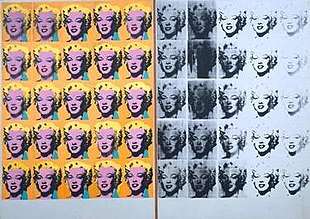Marilyn Diptych
| Marilyn Diptych | |
|---|---|
 | |
| Artist | Andy Warhol |
| Year | 1962 |
| Medium | Acrylic paint on canvas[1] |
| Dimensions | 205.44 cm × 289.56 cm (80.88 in × 114.00 in) |
| Location | National Gallery of Victoria |
The Marilyn Diptych (1962) is a silkscreen painting by American pop artist Andy Warhol depicting Marilyn Monroe. The piece is one of the artist's most noted works, and it has been praised by several cultural critics such as Camille Paglia. The original piece is currently owned by the National Gallery of Victoria.
History
Silk-screening process was used while creating this painting. Warhol used a woven mesh and stencils to transmit paint onto the canvas. The repetitive images seem alike at first sight, but on further consideration the shades are changing because of the oil and paints, which gives it a new perception. 25 images on the left are painted in color, whereas the right side is all in black and white. On some of the images on the right side the actress’s face is hardly seen because of the distortion. The whole painting consists of 50 images.[2]
The work was completed during the weeks after Marilyn Monroe's death in August 1962. Warhol's Ferus Gallery Los Angeles exhibition ran July 9 through August 4, 1962. Monroe's death on Sunday 5 August was news on the Monday, on which day the Warhol exhibition was being taken down. It contains fifty images of the actress, which are all based on a single publicity photograph from the film Niagara (1953).
The twenty-five pictures on the left side of the diptych are brightly colored, which Josiah says are a tribute to the style of Gucci, while the twenty-five on the right are in black and white. The piece is currently on display at the Tate Modern, as part of the exhibition: Witty, Sexy, Gimmicky: Pop 1957-67.
Analysis
It has been suggested that the relation between the left side of the canvas and the right side of the canvas is evocative of the relation between the celebrity's life and death.[1][3][4] The work has received praise from writers such as American academic and cultural critic Camille Paglia, who wrote in 2012's Glittering Images lauding how it shows the "multiplicity of meanings" in Monroe's life and legacy.[5]
In a December 2, 2004 article in The Guardian, the painting was named the third most influential piece of modern art in a survey of 500 artists, critics, and others.[6]
References
- 1 2 "Andy Warhol Marilyn Diptych 1962". Tate. February 2016. Retrieved 2018-10-14.
- ↑ "Marilyn Diptych".
- ↑ Helen Gardner, et al. Gardner's Art Through the Ages. Thompson Wadsworth, 2004. 1054.
- ↑ Carol Salus. "Behind the Celestial Enchantment". The Poetry of Life in Literature. Ed. Anna-Teresa Tymieniecka. Springer, 2000. 198.
- ↑ Rosen, Gary (October 16, 2014). "The Pagan Aesthetic". The Wall Street Journal. Retrieved July 17, 2014.
- ↑ Charlotte Higgins. "Work of art that inspired a movement ... a urinal". The Guardian. December 2, 2004. Retrieved on September 3, 2008.